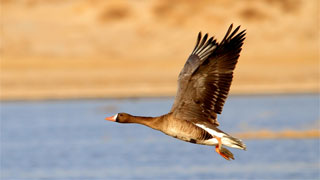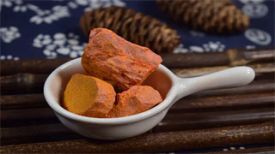
Nicknames: Wu Fat, Yan Gao, Yan Zhi
Harvesting and processing: Capture in winter, remove feathers and internal organs, peel off fat, and use fresh or refine oil for later use.
Medicinal parts: Fat
Origin: Northern Northeast, Eastern Inner Mongolia; The southern part of Northeast China, Baotou, Altai Mountains, and the lower reaches of the Yangtze River; Fujian and Taiwan.
Subject: Duck Family
Original plant: White fronted goose
The male bird has a body length of about 70cm, while the female bird is smaller. Flat mouth with soft skin, flesh colored or rose colored, pointed with keratinized mouth armor, gray or white.
Iris brown. There are white horizontal stripes on the base of the mouth and forehead. The feathers on the head, neck, and back are brown black, with gray white edges. The tail feathers are also brownish black, with white edges. The chest and abdomen are brownish gray with irregular black spots on the fabric.
Young birds do not have this black spot, and there are no white lines on the base of their beak. The legs and feet are orange yellow in color, with 4 toes. The front 3 toes are webbed, the back 1 toe is webbed, the front 3 toes are webbed, and the back 1 toe is small and not touching the ground, with light yellow webbed; Claw short and dull, white or black.
Wild Goose Fat Medicinal Properties:
【 Original text of this sutra 】 It has a sweet and calm taste, with a main wind of spasms and urgency. It has a dry and stagnant qi, and can nourish qi without hunger after long-term use. It is light and tolerant of aging. That is, wild ducks.
Origin: Fat from wild ducks.
[Taste] The taste is sweet, flat, and non-toxic.
【 Treatment 】 Symptoms include shortness of limbs, hemiplegia, and other wind conditions.
[Dosage] There is no specific dosage, it can be consumed.
[Taboo] Do not cook with dog meat, pork, beef, etc., as it may cause diarrhea.
[Taste] Sweet taste; Sexual Peace
[Returning to the Classic] Heart; Liver; Stomach meridian
【 Indications and Functions 】 Tonifying Qi and tonifying Deficiency; Promote blood circulation and relax tendons. Main stroke with partial dryness; Hand and foot spasms; Weakness of waist and feet; deaf; alopecia; Hot chest rash; Ulcer, abscess, swelling and toxin
[Usage and Dosage] Oral administration: decoct soup or oil, appropriate amount. External use: Apply in moderation.
[Attachment]
① To treat wind spasms, shortness of breath, and poor blood circulation: Take four liang of goose fat, refine and filter it, drink one cup of warm wine and one spoonful of fat per day. (From "Food and Medicine Heart Mirror") ② Treatment for BI, swelling under the heart, congestion in the chest, and persistent nausea and vomiting: one piece of goose fat, two liang each of licorice (roasted), angelica, cassia, peony, ginseng, and gypsum (crushed), thirty peach kernels (peeled tip), twenty jujubes (broken), and two liang rhubarb. Add ten flavors, cut them into pieces, boil the goose fat with one bucket of water and two liters, take one bucket of juice and boil various medicines, take five liters, remove the dregs and take them separately. (Wild Goose Fat Soup from "Secret Recipe for Outer Taiwan")
【 Discussions from Various Schools 】
1. The Classic of Canon: The main wind is characterized by spasms, shortness of breath, and imbalance of qi.
2. "Bielu": Long hair and eyebrows.
3. Cui Yuxi's "Classic of Food": The main wind is hot and bothersome, the complexion is calm, and the waist and feet are weak and weak.
4. Meng Qiao: Yan Gao can contain hair growth paste, which can still treat deafness.
5. "Rihuazi Bencao": Fat and bean yellow are used as pills to supplement fatigue and slimming, and to make white people fat.
6. Compendium of Materia Medica: Swelling and ear ulcers. Also treat fever, chest pain, and vomiting. "


